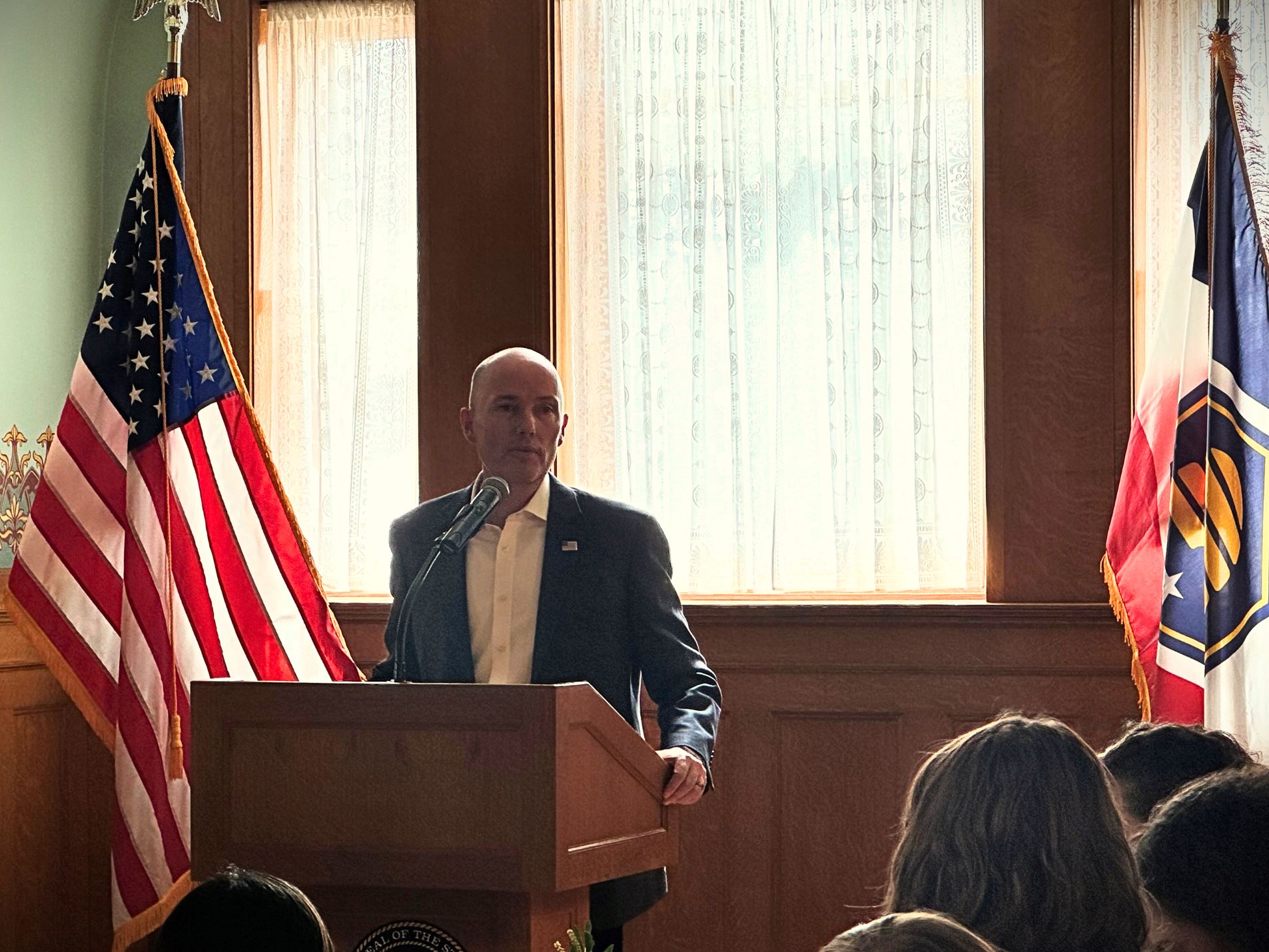Chairman Forbes, Ranking Member Bordallo, distinguished members of the Subcommittee, my name is Terry Branstad, Governor of the State of Iowa. I appear before you today on behalf of the National Governors Association, or NGA, and as Co-Chair of the Council of Governors, or Council. Thank you for the opportunity to speak to you today regarding the U.S. Air Force’s Fiscal Year 2013 budget request and its disproportionate impact on the Air National Guard.
I would like to begin by thanking this Committee for its leadership and support of the Air National Guard. Thanks to your work and that of the Senate Committee, our Air National Guard will continue to have access to the personnel, aircraft and resources necessary to fulfill its dual-mission at home and abroad during Fiscal Year 2013. With your continued support, governors are working with the Department of Defense (DoD) to find solutions to the challenges facing our nation’s military forces. I am hopeful we can find ways to fully leverage the operational strengths and cost savings of the Air and Army National Guard, as we move forward.
Overview
Governors care deeply about their dual responsibilities to support both the federal missions and homeland security requirements that our National Guard soldiers and airmen help fulfill every day. For my own State, we have been deploying airmen overseas since the mid-1990s in support of the No-fly missions and peacekeeping operations in Kosovo, Sinai Peninsula, and Kuwait. Since 9/11, more than 17,000 Iowa National Guard soldiers and airmen have served on active duty in support of the nation’s efforts overseas. As a Governor, I truly understand the deep connection between my colleagues and those who serve their state and nation. I also take seriously the responsibilities I have to our returning veterans and to the families whose loved ones have made the ultimate sacrifice for this nation. In Iowa, we have lost 78 servicemembers in the War on Terror.
The National Guard has effectively balanced both mission sets at the same time. Just this last year, the Iowa National Guard deployed the 2nd Brigade Combat Team to Afghanistan in a full-spectrum mission set, making it the largest deployment of Iowa National Guard soldiers and airmen since World War II. At the same time, we were also responding to the historic Missouri River floods with approximately 1,000 National Guard servicemembers, making this the longest duration emergency response operation in our State’s history.
As commanders-in-chief, governors take very seriously the duties and responsibilities placed on the men and women of the National Guard. We appreciate the need to reorganize, restructure and modernize the military to meet new threats and economic realities. We also understand the need for cost-effective means to achieve these goals. Governors across the country have made tough choices, but done so in a thoughtful way to leverage the most cost-effective resources available. In the State of Iowa, we continually look for innovative ways to deliver services and have sought ways to better leverage private sector strengths through public-private partnerships. I know that many Iowans at entities like Alcoa, Rockwell Collins, and the Rock Island Arsenal stand ready to help the Pentagon get the most out of their resources.
The Guard is a cost-effective operational force that is critical to our national security and our ability to respond to domestic emergencies. The Air National Guard provides 35 percent of the U.S. Air Force’s capability for six percent of the budget.
Therefore, when the Air Force proposed to impose 59 percent of the total aircraft budget reductions and about six times the personnel reductions on the Air National Guard, nearly every governor signed a letter to Defense Secretary Panetta strongly opposing the Air Force’s budget proposal (letter attached).
Governors’ Concerns with FY2013 Air Force Budget
The Council is a presidentially-appointed bipartisan group of 10 governors and senior federal officials including the Secretary of Defense, the Secretary of Homeland Security and White House officials. The Council provided an opportunity to discuss governors’ concerns with Secretary Panetta, Air Force Secretary Michael Donley and Air Force Chief of Staff General Norton Schwartz on February 27.
At that time, I – along with my Council co-chair, Governor Chris Gregoire of Washington – relayed governors’ frustration and dismay at having to read about the proposed cuts to the Air National Guard in the newspaper.
While we do not expect to be involved in the day-to-day operational decisions of DoD, we were disappointed by the lack of communication with us on such an important decision impacting the Air National Guard. We were also concerned by the dramatic nature of the proposal and its failure to recognize the role and importance of the Air National Guard in our states and the experience and cost effectiveness that the Air National Guard provides to the Total force.
Governors routinely rely on the National Guard to respond to emergencies. The National Guard has highly trained and readily accessible personnel and equipment that provide critical capabilities such as transportation, communications and medical response. The proposed reductions to the ANG would have stripped states of these capabilities and upended years of carefully crafted emergency response plans. I am now in my 18th year as governor and the Iowa National Guard has always performed to the highest of standards in the toughest of conditions.
During the Council meeting on February 27, Secretary Panetta indicated that he understood our concerns and agreed to work with us to try to find a solution.
Following that meeting, my Adjutant General, or TAG, Major General Timothy Orr, as well as Governor Gregoire’s TAG, Major General Timothy Lowenberg, engaged in discussions with the Air Force to try to identify a better solution for FY2013.
While there were several discussions in early- to mid-March, significant differences remained with respect to manpower reductions, fighter aircraft and airlift needs.
On March 19, Governor Gregoire and I spoke with Secretary Donley and General Schwartz regarding insufficient progress to address governors’ concerns. By letter on that same day, we encouraged them to consider cost neutral options for cross-leveling or reallocating programmed aircraft operations from the active service to the Guard (letter attached).
Unfortunately, despite our outreach to the Air Force leadership and Deputy Defense Secretary Carter (letter attached), the negotiations did not resolve key differences.
On April 23, Secretary Panetta shared a letter with us that he had sent to Congress (attached) in which he proposed to transfer 24 C-130 units from the active service to the Air National Guard. While we appreciate the Secretary’s recognition of governors’ need for greater airlift capacity, the proposal was previously presented by the Air Force and fell short of addressing our concerns. As we had discussed with Secretary Donley and General Schwartz, this proposal failed to leverage the Guard’s cost effectiveness to retain additional manpower, expertise, and fighter aircraft at a reduced cost to taxpayers.
Future Years’ Budget Proposals
Thankfully, this Committee, as well as the Senate Armed Services Committee, has put forward legislation to preserve Air National Guard manpower and aircraft at current levels for another year. This temporary freeze will provide opportunities to exchange views, information and advice on state and DoD requirements for future fiscal years.
The Council is working on principles and appropriate coordination points for an open channel of communications between states and DoD on matters impacting the National Guard and its dual missions at home and abroad.
One item we have identified that contributed to this year’s challenges was the Air Force’s requirement that National Guard Bureau officials sign non-disclosure agreements on the budget process. Such a requirement creates an unnecessarily restrictive process that fails to adequately incorporate critical information from states.
The National Guard Bureau is statutorily required to serve as the channel of communications between states and the President and Secretary of Defense. Unnecessarily restricting the ability to share discreet but critical information with governors and their TAGs limits the flow of information and has resulted in disagreements that could have been largely avoided.
This is just one item we hope to discuss with DoD during the upcoming Council meeting this weekend.
As you know, the FY2014 budget proposals for the Air Force and the Army have already been developed and will soon be sent to the Secretary for his review. Without quick action to ensure communications with states, we may be faced with similar budget disagreements next year.
We are hopeful that the ongoing focus by Congress and the Senate Committee’s proposed National Commission on the Structure of the Air Force will encourage DoD, the Air Force and the Army to work with us as quickly as possible to establish a better, more collaborative process for the FY2014 and FY2015 budgets.
On behalf of the nation’s governors, I thank you for your strong support of our National Guard. Your continued assistance and support will be helpful as governors work with DoD to craft solutions to the problems we share.
Thank you for the opportunity to testify before you today. I look forward to answering any questions you may have.












